
This article was originally published Oct. 12, 2020, on Sandboxx News. Follow Sandboxx News on Instagram.
Two years ago, North Korea’s nuclear weapons programs were at the forefront of many American’s minds, as each subsequent test seemed to demonstrate increasing strategic capability. Atomic tests gave way to apparent hydrogen (or thermonuclear) tests. Ballistic missile tests gave way to intercontinental ballistic missile tests, and soon, it seemed all but clear that North Korea now possessed the capability to strike the American mainland with a nuclear weapon.
President Trump’s administration adopted an aggressive posture in dealing with North Korea’s provocations, and in many ways, that aggressive posture seemed to pay dividends. North Korea’s Kim Jong Un met with both South Korean and American leaders, including President Trump himself, and the nuclear tests came to an end. It seemed, at least for the moment, that America had postponed a North Korean nuclear standoff, but there was little doubt that Kim’s days of saber rattling were far from over.
Last Saturday, those suspicions were confirmed as North Korea held a widely publicized military parade that made it clear that Kim Jon Un’s nuclear ambitions have not wained. On display alongside a number of important military developments shown during the parade (like a new submarine-launched ballistic missile and new body armor for troops), was a new intercontinental ballistic missile that seems to positively dwarf North Korea’s previous premier nuclear weapon, the Hwasong-15 (or HS-15).
Of course, North Korea has a long an illustrious history of faking significant defense developments for the sake of the global press, and even the nation’s claims about its existing nuclear arsenal are often seen as, at the very least, littered with exaggeration. So while this new missile looks a whole lot bigger than the missile North Korea has already demonstrated could reach American shores, we should take analytical extrapolations about its potential capability with a grain of salt.
However, based on what we know about North Korea’s previous ballistic missile programs, the state of its nuclear weapons programs, and the basics of missile technology, there are some assumptions we can make about this new weapon… and what it means for America’s relations with the hermit nation.
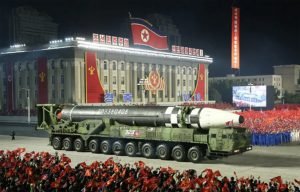
Bigger is probably better
This new missile, which for the moment lacks an official name we’re aware of, is significantly bigger than the longest-range missile in North Korea’s arsenal, the HS-15. The HS-15 was first tested in 2017, and based on the missile’s trajectory, altitude, and flight time, scientists have estimated it to have an operational range of great than 8,100 miles — giving it the legs it needs to target the American capital city of Washington D.C. The new missile shown in Saturday’s parade is significantly larger than the HS-15.
All of that added size could mean this new missile has far greater range than even the HS-15 offered, but for North Korea’s purposes, that may not be the most important development they could have pursued over these past years of relative quiet. Instead, it seems more likely that all this added size (and accompanying fuel) are for the benefit of a larger payload.
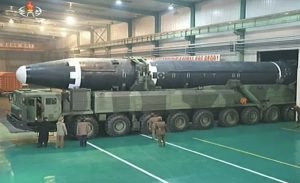
The assumption then could be that this new missile was developed specifically to utilize multiple independently targetable reentry vehicles (MIRV) to great increase the potential damage of a single missile strike while simultaneously making it more difficult to intercept the deployed nuclear warheads as they close with their varied targets. This is a common approach adopted by nations like the United States, Russia, and China for their own nuclear weapons — to include Russia’s positively massive RS-28 Sarmat, which can carry between 10 and 15 reentry vehicles and destroy swaths of land as large as Texas or France with a single launch, according to Russian press statements.
North Korea is believed to possess thermonuclear weapons, but it is unlikely that their new ICBM is as powerful as Russia’s latest doomsday machines… but that doesn’t mean a MIRV-capable North Korean ICBM isn’t something that should prompt a few concerns. If a single nuclear weapon was a significant concern in 2017, a single missile with multiple nuclear weapons certainly represents a more potent threat today.
Do we know for sure that North Korea’s missiles can really reach U.S. soil?
Based on the math gathered during North Korea’s previous missile tests, it seems entirely likely that Kim Jong Un could order a missile strike on the continental United States and potentially even succeed in doing so. The United States maintains multiple overlapping layers of missile defenses, from THAAD launchers on the Korean Peninsula to Aegis destroyers at sea, and finally America’s own ground based midcourse defense (GMD) system designed to protect the U.S. from inbound nuclear missiles. Unfortunately, intercepting even a massive nuclear missile is sort of like shooting a bullet at another bullet from the other side of the globe… it’s no easy undertaking.
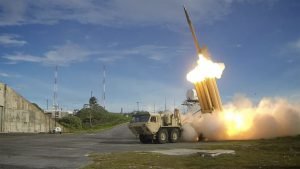
America’s GMD missile defense system’s procedure includes firing up to five kinetic interceptors at any one incoming missile to improve the chances of success. This approach works well for one inbound missile, but there’s no denying that even America’s overlapping missile defense approach would quickly get overwhelmed by a flurry of launches — That’s why America still maintains its nuclear triad and the Mutually Assured Destruction (MAD) doctrine. America knows it can’t stop every inbound nuke in a nuclear war, so the best we can do is promise nuclear annihilation in return.
However, there are some elements of North Korea’s ICBM program that have yet to prove themselves in testing, and while there is evidence to suggest these missiles work, some questions do remain. North Korea has yet to fully demonstrate the survivability of their reentry vehicles, meaning that the warheads themselves have yet to survive reentry from orbit all the way down to the surface in the area the missile targeted (most often, open sea).
U.S. intelligence has suggested that they’ve seen reentry vehicles survive down to nearly one kilometer above earth’s surface, which is far enough for a powerful airburst detonation that would be extremely effective. It’s also worth noting that the vehicle in question re-entered the atmosphere at an angle of descent that caused more friction and heat than a strike against U.S. soil likely would, suggesting the warhead could have survived all the way to its target.
There has also been little to suggest that North Korea’s ICBM program has a reliable targeting apparatus, but that may not matter, particularly in this case of this new, larger ICBM. Like the Soviet Union (and even some modern Russian ICBMs), lacking in accurate targeting capability isn’t that big of an issue when we’re talking about the destructive force of a nuclear weapon. If this new weapon truly does carry multiple warheads, that becomes increasingly true: North Korea doesn’t need good aim when it can shotgun blast nukes in America’s direction.
What does this really mean for North Korean/US Relations?
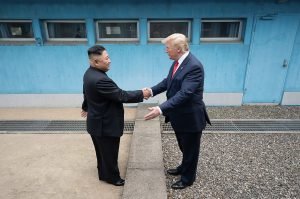
Most pertinently, this new missile (as well as the, perhaps more strategic valuable, SLBM also unveiled in the parade) clearly demonstrates that President Trump was not as successful as many may have hoped when it came to dissuading Kim’s pursuit of more advanced and capable nuclear weapons. While testing may have been on a hiatus, development clearly was not — nor will it be in the years ahead.
In a real way, this new development brings North Korean/U.S. relations back to a sort of starting point, before Trump and Kim jabbed at and courted one another in public remarks. North Korea and its leader, Kim Jong Un, aren’t pursuing open war, but rather leverage that can be used to force the world’s economies to open back up to his struggling nation. Despite Kim’s clear investment in military hardware, evidence remains to suggest that North Korean troops are practically starving, and that things aren’t any better for the majority of the populous amid ongoing sanctions.
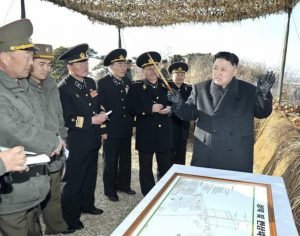
Kim’s intent has always been to come to the negotiating table as an established nuclear power that cannot be ignored, and both of these new missiles bring him closer to that intended aim. The United States, which has largely dismissed North Korea’s military provocations in the past, will be forced to engage with these threats more directly now that the nation has the real capability to launch a nuclear strike — which some could argue was why Trump himself took such a new approach to dealing with the leader of the reclusive state. Trump has been the first American president faced with an actually nuclear-armed North Korea, which is, there’s no beating around the bush here, a more potent threat than North Korea has posed in decades.
Whether President Trump or Vice President Biden win the upcoming election, North Korea’s parade has made Kim’s intentions clear: America coming back to the negotiating table, and if Kim has his way, an easing of economic sanctions put in place to deter his nuclear pursuits. North Korea wants to talk while holding a nuclear gun to America’s head, and while there’s no doubt who would win in such a conflict, the truth is, the losses would be so severe that winning wouldn’t be all that great either.
So, what does this new missile really mean? More of the same, but with higher stakes than ever.

Coffee or Die is Black Rifle Coffee Company’s online lifestyle magazine. Launched in June 2018, the magazine covers a variety of topics that generally focus on the people, places, or things that are interesting, entertaining, or informative to America’s coffee drinkers — often going to dangerous or austere locations to report those stories.
BRCC and Bad Moon Print Press team up for an exclusive, limited-edition T-shirt design!
BRCC partners with Team Room Design for an exclusive T-shirt release!
Thirty Seconds Out has partnered with BRCC for an exclusive shirt design invoking the God of Winter.
Lucas O'Hara of Grizzly Forge has teamed up with BRCC for a badass, exclusive Shirt Club T-shirt design featuring his most popular knife and tiomahawk.
Coffee or Die sits down with one of the graphic designers behind Black Rifle Coffee's signature look and vibe.
Biden will award the Medal of Honor to a Vietnam War Army helicopter pilot who risked his life to save a reconnaissance team from almost certain death.
Ever wonder how much Jack Mandaville would f*ck sh*t up if he went back in time? The American Revolution didn't even see him coming.
A nearly 200-year-old West Point time capsule that at first appeared to yield little more than dust contains hidden treasure, the US Military Academy said.












